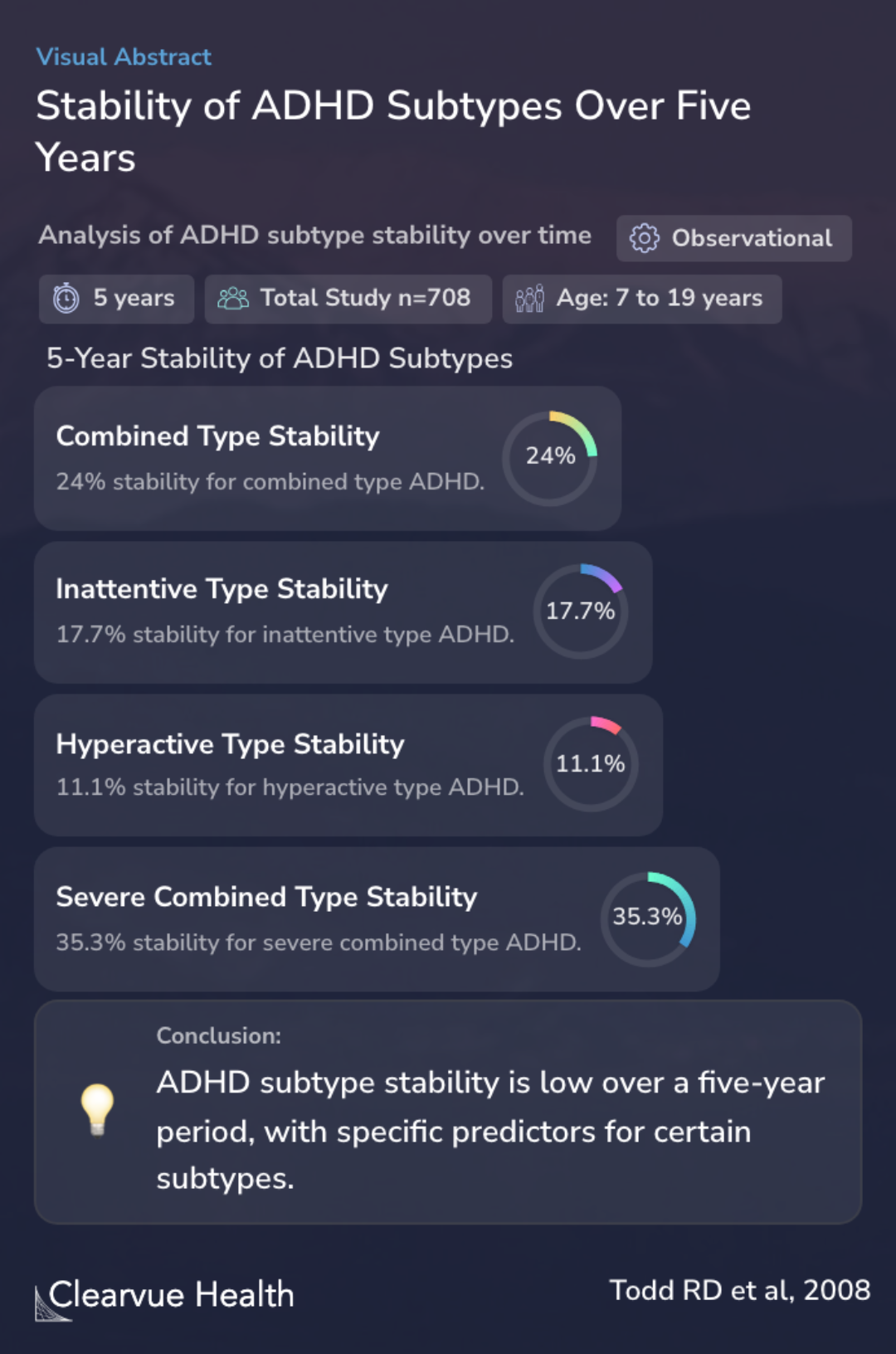Predictors of stability of attention-deficit/hyperactivity disorder subtypes from childhood to young adulthood
Stability of ADHD Subtypes Over Five Years
Todd RD, Huang H, Todorov AA, Neuman RJ, Reiersen AM, Henderson CA, Reich WC

Objectives
The study embarked on an investigation to understand the consistency of ADHD subtypes over a five-year period. Specifically, it aimed to evaluate how stable these subtypes are and what factors might influence their stability. This is crucial because understanding the stability of ADHD subtypes can help in tailoring more effective treatments and interventions for individuals with ADHD.
To determine the 5-year prospective stability of population-based and DSM-IV subtypes of attention-deficit/hyperactivity disorder (ADHD) as well as to explore predictors of stability.
Methods
In this observational study, the authors reassessed 708 twins from Missouri, aged between 7 to 19 years, after a five-year period. The twins, who had been part of a previous ADHD study, were evaluated again to compare the stability of both DSM-IV and population-based ADHD subtypes. Using statistical methods, such as the kappa statistic and multivariate logistic regression, they aimed to understand the degree to which these subtypes remained consistent over time and what factors might predict this stability.
A total of 708 twins ages 7 to 19 years who were identified from birth records of the state of Missouri and had participated in a study of ADHD were reassessed 5 years later in a blinded fashion. Stabilities of DSM-IV and population-based ADHD subtypes were compared using percentage of a...
Results
The study's results indicated that the stability of ADHD subtypes over a five-year period was generally low to modest. For DSM-IV subtypes, the stability ranged from 11.1% to 24.0%, while for clinically significant population-derived subtypes, it ranged from 14.3% to 35.3%. Interestingly, the study found no universal predictors of diagnostic stability across all subtypes. However, they identified certain subtype-specific predictors. For instance, a diagnosis of oppositional defiant disorder was a predictor for the DSM-IV primarily inattentive ADHD subtype; lower verbal IQ was linked to the DSM-IV combined type ADHD; and younger age, oppositional defiant disorder, and medication use were associated with population-defined severe combined ADHD.
In general, 5-year ADHD subtype stability was poor to modest and ranged from 11.1% to 24.0% for DSM-IV subtypes and from 14.3% to 35.3% for clinically significant population-derived subtypes. There were no predictors of diagnostic stability that applied across subtypes. There were subtyp...
Conclusions
Concluding the study, the authors found that population-defined ADHD subtype criteria showed slightly better diagnostic stability over the five-year period compared to DSM-IV subtypes. Nevertheless, the overall low stability of ADHD subtypes, along with the minimal identification of consistent predictors, highlights the complexity and variability inherent in ADHD. This finding aligns with broader research indicating that ADHD subtypes are not only real and distinct but also impact individuals' lives in diverse ways, necessitating personalized approaches in treatment and management.
Population-defined ADHD subtype criteria demonstrated modestly improved diagnostic stability over 5 years compared to DSM-IV subtypes. Few correlates or predictors of stability were identified.
Key Takeaways
Context
ADHD subtypes have been found to significantly impact people's lives in various ways. For instance, a study by Graetz et al. in 2001 revealed that ADHD is prevalent in 7.5% of Australian youths, with the combined type being most impaired, particularly in social settings.
ADHD affects adults differently, and studies have looked at different subtypes in adults.Wilens et al. in 2009 highlighted that most adults with ADHD showed inattentive symptoms, with variations in subtype prevalence and comorbidity.